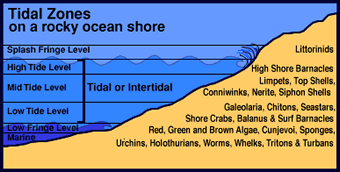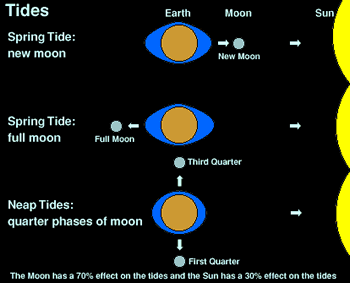|
|
The
Tidal Zone
Eastern Warm Temperate Zone
This region is generally covered and uncovered by the tide at least twice each day for south-eastern Australia. This is the region which is truly "intertidal".

What Causes the Tides
Gravitation is an attraction between masses. Large masses such as the Moon, the Earth and the Sun have a gravitational effect upon one another. If not, the Earth and the Moon would fly off into space from their orbits around the Sun.
When we consider two bodies, gravitation is proportional to the product of the masses of the two bodies and inversely proportional to the square of the distance between them.
Although the Moon is much smaller than the Sun, it plays a much larger effect upon the Earth's tides. The Sun's effect, is only 47% as great as the moon's effect.
About 70% of the Earth is covered by water, so when the Moon orbits the Earth, there is a bulge of water underneath it. On the other side of the Earth is another high-tide water bulge caused by centrifugal force.
The moon orbits the Earth every 27.5 days (called the lunar month), but the Earth revolves on its axis every 24 hours (one full day).
So, while the high tide bulge of water lies directly under the Moon, and on the other side of the Earth, the solid Earth revolves underneath the liquid bulges of water. In other words, the high tide remains more or less stationary underneath the moon, while the Earth revolves through it.

Spring High Tide
When the Moon and Sun are on the same side of the earth, and all are in a line, this causes a New Moon. When the Moon is on one side of the Earth and the Sun is on the other, and all are in line, we get a Full Moon. Both these situations cause the extra high and low tides called the Spring Tides, one each lunar month. There are thirteen lunar months each year.
Neap High Tide
When the Sun, Moon and Earth are not in a direct line, the Sun's gravitational effect works against the Moon, so the tidal variation is not as great. At the time of the First Quarter phase of the Moon and the Third Quarter phase of the Moon, we get the not-so-high and not-so-low Neap Tides, one each lunar month.
But the Earth is not a liquid ball of water, and the land masses of the continents greatly complicate the effects of the tides and cause all sorts of variations.
The Eastern and Western Australian Situation
In both eastern and western Australia we get two high tides and two low tides every 24 or so hours.
In south-eastern Australia we have a two metre tidal range, caused by the Pacific Ocean banking up against the coast as the solid Earth spins under the blanket of water. So in the "pool" of the Pacific Ocean, the variation between high and low tide is not so great along the South American coastline and is greater against the Australian coast.
In the west, the Indian Ocean banks up against the South African coast, and the tidal range is not so great along the western Australian coast. South Western Australia only has a one metre tidal range.
The Southern and Northern Australian Situation
Not all of Australia gets two tides each day. Across southern Australia and northern Australia, due to the canceling or competing effects of the Pacific and Indian Oceans, there may only be one high tide and one low tide in 24 hours.
Occasionally on South Australian shores there may be a "dodge tide", where the tide may remain fairly stationary for a couple of days. If this occurs during the hot summer months and there is a strong searing wind blowing from the arid interior, all creatures of the high shore will perish.
South-eastern Australia, including New South Wales and Victoria and Tasmania, has a 2 metre tidal range, while south-western Australia has a 1 metre tidal range.
Splash-Fringe
Level
The Tidal Zone
• High-Tide level
• Mid-Tide Level
• Low-Tide Level
Low fringe Level
Marine Zone
Home
Page
Taxonomy
Biogeography
Rocky Shores
Tidal Levels
Intertidal Zonation
Environmental Factors
Biological
Factors
Feeding Relationships
Activities
Glossary
References
 Life
on Australian Seashores
Life
on Australian Seashores
by Keith Davey (C) 2000
Learning Consultant
- Media
The University of Newcastle
email at australian_seashores@hotmail.com
Scientific Consultant: Phil
Colman
site created 01.01.98 : updated 01.04.2000
